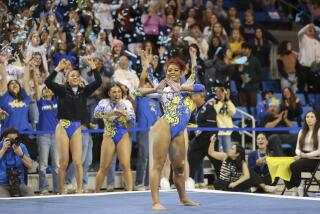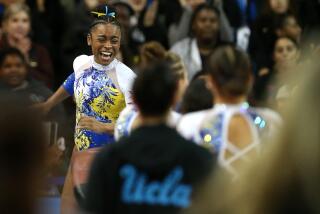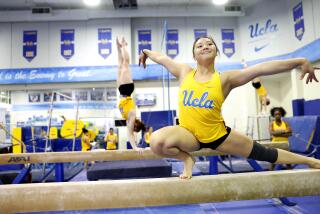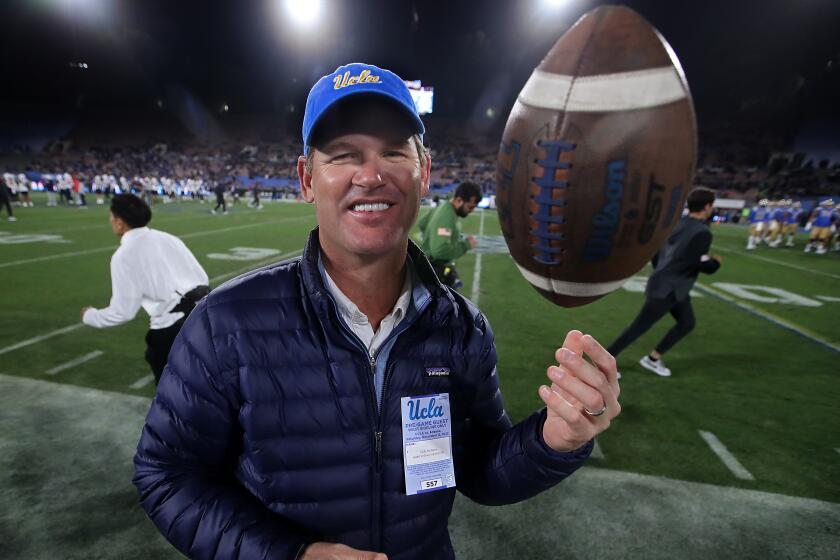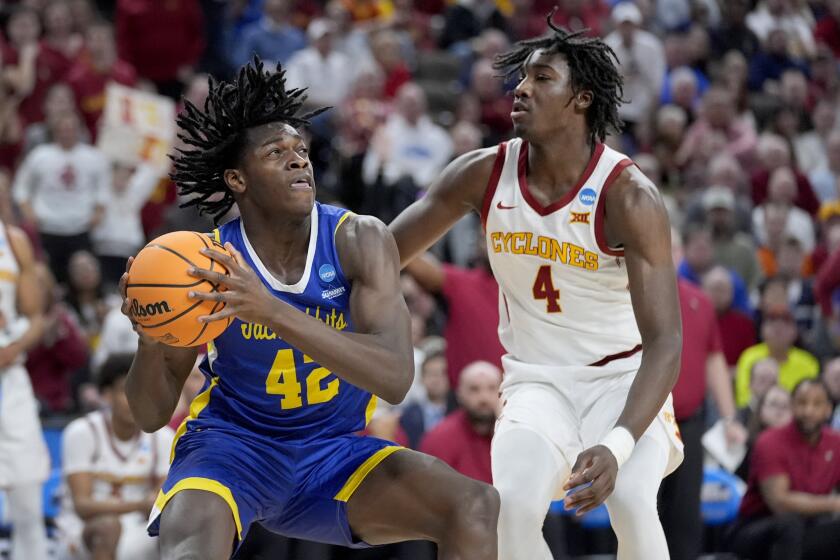Column: UCLA gymnastics has an Olympic aura surrounding its program
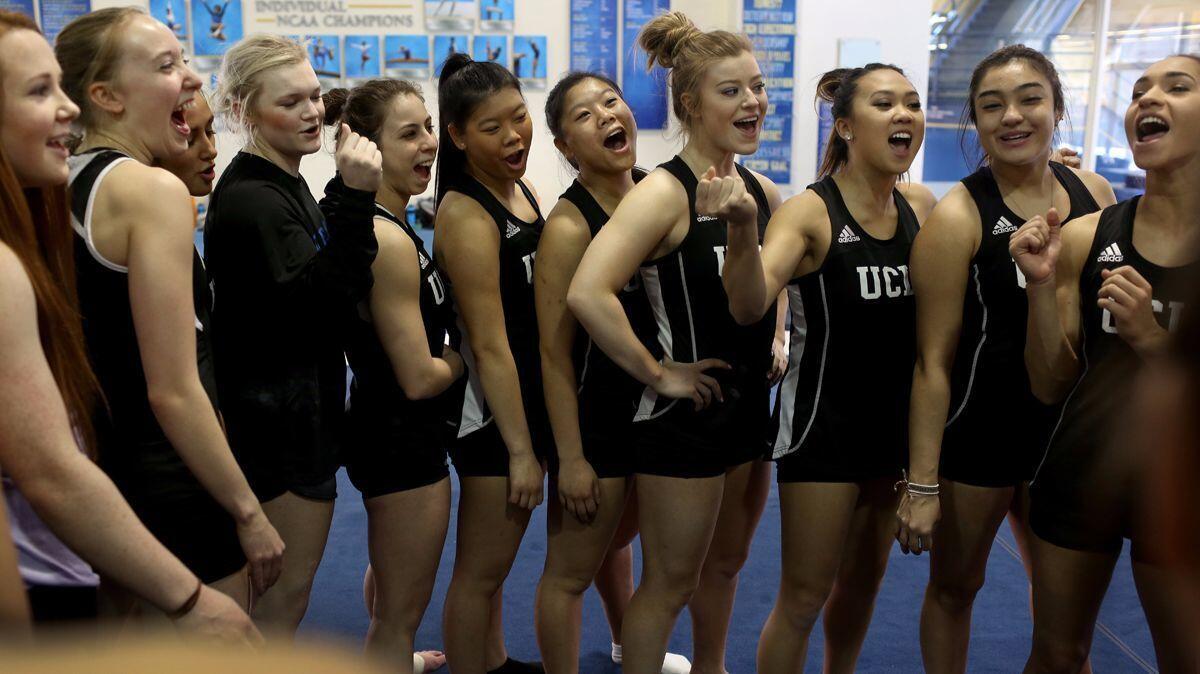
Chalk dust rises in small puffs and floats through the air at the John Wooden Center as members of UCLA’s women’s gymnastics team await their turns at practice. The dust is an occupational hazard but it becomes an art form when one young woman offers a comforting hug to another who stumbled off the mat, an embrace that leaves ghostly handprints on the back of the now-smiling teammate’s shirt.
The air is filled with bouncy music and joyful noise, the sound of athletes who respect each other and the sport they perform so well. Kyla Ross, who helped the U.S. win a team gold medal at the 2012 London Olympics, laughs after an errant vault. Madison Kocian, a team gold medalist and silver medalist on the uneven bars in the 2016 Rio Games, does an enviably precise routine on the bars in the far corner. Christine Peng-Peng Lee, honorary captain of Canada’s 2012 Olympic gymnastics team, practices a double-turn on the balance beam and does many intricate moves even though they won’t earn her extra credit in college gymnastics’ scoring system.
The Bruins are ranked No. 4 in the country and gaining momentum in their quest for a national championship. Last Sunday, they set a school dual-meet attendance record by drawing 12,576 fans to Pauley Pavilion. In that victory over California, Katelyn Ohashi became the fourth Bruin this season to earn a perfect 10, after Ross, Kocian and Lee.
At a practice last week, they focused on their routines but always supported each other, thriving in a nurturing atmosphere. Yes, Allen Iverson, we’re talking about practice.
“We talk about gratitude every day — every single day — at the beginning of practice. And we talk about being grateful that we live in a country where we as women can play sports,” said Valorie Kondos Field, who has guided the team to six NCAA titles and was chosen the Pacific-12 conference’s coach of the century.
“They have embodied that appreciation, that gratitude, that ‘Let’s not make this bigger than what it is.’ And in honoring that, we’re going to come in every day and work as hard as we possibly can and we’re going to compete as hard as we can and every year we’re going to compete and train to win another national championship, but we’re going to do it from a place of gratitude, not entitlement.”
There’s no sense of privilege, even for the team’s many world-class gymnasts. But the Olympics are in the Bruins’ DNA, and one wall of the gym displays a list of UCLA gymnasts who competed in the Games. Kondos Field likes to tell young gymnasts about Jordyn Wieber, another member of the golden “Fierce Five” in London, who became a UCLA team manager and volunteer assistant coach when she lost her eligibility. “She moved mats. She chalked the bars. She did laundry,” Kondos Field said. “And when you’ve got a 7-year-old and you see Jordyn Wieber, a gold medalist, pulling mats and chalking the bars, what a great example for your children.”

That humility is natural. “I think it’s we all come into the gym and we’re all gymnasts on the UCLA gymnastics team,” said Ross, a freshman from Aliso Viejo and a bioengineering major. “A lot of us do have outside experience before here. There’s quite a few elites and Olympians. I think we all share the same bond and the same goal, which is to compete as well as we can as a team and hopefully win that national championship.”
There’s a vast difference between elite and college gymnastics. Elite gymnasts usually have four meets a year; the Bruins will have 16, including Sunday’s home finale against North Carolina. Elite gymnasts train 40 or more hours a week; the NCAA has a 20-hour weekly limit. “That was a ginormous transition,” Ross said. “Being an elite, growing up I was very sheltered. I did go to public high school but would always leave before lunch. I didn’t have very many friends. Coming here, I’ve met so many people. I’ve definitely grown out of my shell and become more comfortable with who I am.”
It’s still a whirlwind for Kocian. “I think it was a little bit of a harder transition for me because I came straight from the Olympics so I really haven’t had too much down time,” she said. “That’s the biggest and hardest thing for me right now, just dealing with a few injuries here and there, and fatigue. It’s not something really terrible and I’m glad to be here and pushing through with my teammates. I couldn’t do anything, for sure, without their support. It’s been challenging but at the same time very fun.”
Lee challenges herself by performing difficult moves for the sake of the sport, not for extra points. “When I came to college people were like, ‘Wow, you’re doing such big skills,’ and it was just from before,” the red-shirt senior said. “It’s kind of neat just to impress them in that way.”
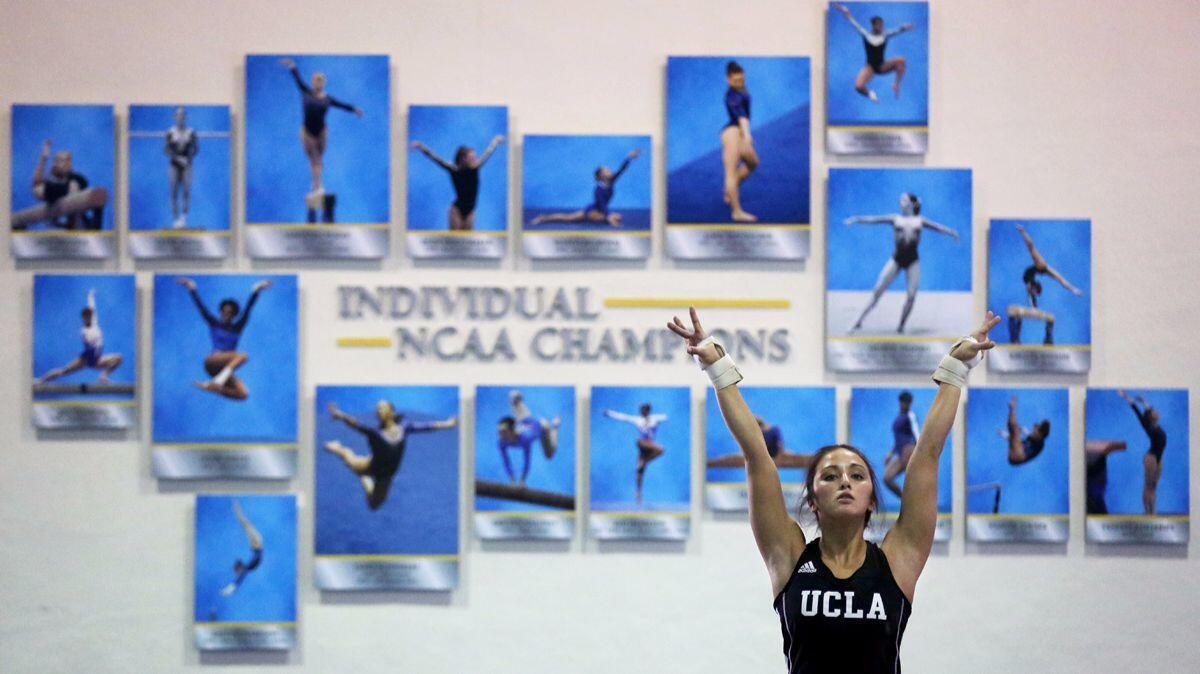
Kondos Field said this team reminds her of those she coached in the early 2000s. The Bruins won NCAA titles in 2000, 2001, 2003 and 2004. “Not just because of the Olympic-star power,” said Kondos Field, whose teams also won titles in 1997 and 2010, “but because of the excitement, the enthusiasm and the confidence knowing that we can go out weekend after weekend and put up brilliant gymnastics.”
They do it while entertaining fans and having a good time. Kocian said Kondos Field “is very fun to be around. She’s like my second mom.” Kocian added, “I know I can talk to her for anything. It’s been fun coming here and I’ve had so much fun just traveling with the team and the coaches and especially Miss Val.”
Everyone calls Kondos Field “Miss Val,” a nod to her background in ballet. It started on her first day as UCLA’s dance coach in 1982 with a snarky remark from a gymnast in the ballet room and has stuck. “I think it has a nice little ring to it,” she said. “Even some of family calls me that.”
They also can call her and her athletes winners.
Follow Helene Elliott on Twitter @helenenothelen
More to Read
Go beyond the scoreboard
Get the latest on L.A.'s teams in the daily Sports Report newsletter.
You may occasionally receive promotional content from the Los Angeles Times.
